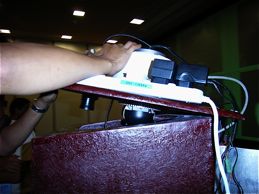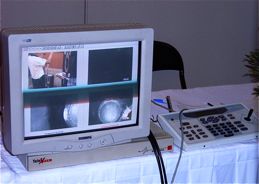The Singapore Hornbill Project that is being coordinated by Marc Cremades and Prof Ng Soon Chye has seen success in the use of nest boxes that provide much needed nesting cavities for the Oriental Pied Hornbills (Anthracoceros albirostris) at Singapore’s offshore island of Pulau Ubin (left). The population of the hornbill has since increased significantly.
At the 5th International Hornbill Conference co-hosted by Singapore’s National Parks Board and Thailand’s Hornbill Research Foundation that completed its deliberations yesterday, a new-generation nesting box, used in the wild as well as in the Jurong BirdPark, was unveiled.
Fitted with four to five video cameras, this nesting box can make round the clock recordings. Infrared cameras monitor night activities, dome cameras mounted at the top of the nesting box record nesting activities (below left) and others monitor activities around the box. There is also a built-in electronic weighing machine that allows for the weight of the nest occupants to be monitored. The weight of the visiting male hornbill is also recorded via a perch provided near the entrance. Temperatures and humidity are also monitored round the clock.


Originally powered by large batteries, there is now a solar panel to power the entire system.
All the images captured by the video cameras, inside and outside the nesting box, as well as data collected by the instruments, are fed to a computer (above right). These can be viewed or saved for processing later.
So far, the new-generation nesting boxes that have been set up have provided exciting information on nesting that has not been reported before. Of these, parental infanticide has already been posted earlier, documented with an earlier generation nesting box.
Reference:
Marc Cremades, Lai Huimin, Alan Tan Yong Hong, Minerva Bongco-Nuqui & Ng Soon Chye (2009). Artificial nests in the propagation and survey of the Oriental Pied Hornbills in Singapore – in the wild and in captivity. Paper presented at the 5th Intn. Hornbill Conference, Singapore, March 2009.









